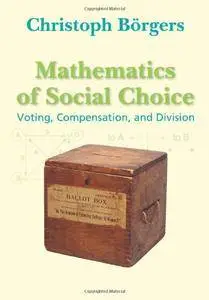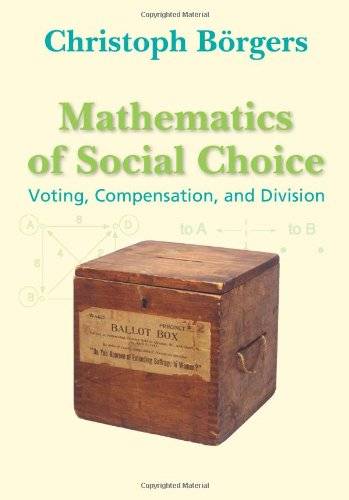English | 2010 | ISBN: 0898716950 | 257 Pages | PDF | 1004.32 KB
How do you select a winner from a field of candidates? How do you rank a field of candidates? How do you share a divisible resource like a cake, or an indivisible one like a pet or a house? These are the questions addressed in this fun and accessible book that takes an entertaining look at the choices made by groups of people with different preferences, needs, and interests.
Divided into three parts, the text first examines voting methods for selecting or ranking candidates. A brief second part addresses compensation problems wherein an indivisible item must be assigned to one of several people who are equally entitled to ownership of the item, with monetary compensation paid to the others. The third part discusses the problem of sharing a divisible resource among several people.
Mathematics of Social Choice: Voting, Compensation, and Division can be used by mathematics majors as well as students whose only mathematical background is elementary algebra. Material geared toward more sophisticated readers can be skipped without any loss of continuity. The book includes many elementary and usually simple, but rigorous mathematical proofs appropriate for beginning mathematics majors. Students will also find appendices with background material on set notation, logic, and mathematical induction and solutions to many of the homework exercises.
Audience: This book is primarily addressed to readers without a high-level mathematical background, such as college students majoring in subjects other than mathematics and advanced high school students. However, some material appropriate for more sophisticated readers is included in small print, and makes the text appealing to undergraduate mathematics majors interested in learning about applications of mathematics in the social sciences. The book can also serve as an easy introduction to topics such as the Gibbard Satterthwaite theorem, Arrow's theorem, and fair division for readers with more mathematical background.
Contents: Preface; Part I: Voting: Chapter 1: Winner selection; Chapter 2: Rule of the majority; Chapter 3: Election spoilers; Chapter 4: The Smith set; Chapter 5: Smith-fairness and the no-weak-spoiler criterion; Chapter 6: Schulze s beatpath method; Chapter 7: Monotonicity; Chapter 8: Elections with many or few voters; Chapter 9: Irrelevant comparisons and the Muller Satterthwaite theorem; Chapter 10: Strategic voting and the Gibbard Satterthwaite theorem; Chapter 11: Winner selection versus ranking; Chapter 12: Irrelevant alternatives and Arrow s theorem; Part II: Compensation: Chapter 13: Fairness and envy-freeness; Chapter 14: Pareto-optimality and equitability; Chapter 15: Equality, equitability, and Knaster s procedure; Part III: Division: Chapter 16: Envy-free, Pareto-optimal, and equitable cake cutting; Chapter 17: I cut, you choose for three: Steinhaus s method; Chapter 18: Hall s marriage theorem; Chapter 19: I cut, you choose for more than three: Kuhn s methods; Chapter 20: The method of Selfridge and Conway; Chapter 21: The geometry of Pareto-optimal division between two people; Chapter 22: The adjusted winner method of Brams and Taylor; Chapter 23: Conflict resolution using the adjusted winner method; Chapter 24: The effect of dishonesty on the adjusted winner method; Chapter 25: Proportional allocation; Chapter 26: Dividing a piecewise homogeneous cake among more than 2 people; Part IV: Appendices: Appendix A: Sets; Appendix B: Logic; Appendix C: Mathematical induction; Appendix D: Solutions to selected exercises; Index.



